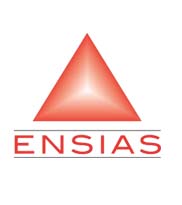- Accueil
-
L'Ecole
-
FORMATIONS
-
FORMATION INGENIEUR
-
Nouvelles filières offertes
- Ingénierie Intélligence Artificielle (2IA)
- Smart Supply Chain & Logistics (2SCL)
- Business Intelligence & Analytics (BI&A)
- Génie de la Data (GD)
- Génie Logiciel (GL)
- Ingénierie Digitale pour la Finance (IDF)
- Smart System Engineering (SSE)
- Data and Software Sciences (D2S)
- Cybersécurité, Cloud et Informatique Mobile (CSCC)
- REGLEMENT DES ETUDES DE L’ENSIAS CYCLE INGENIEUR
-
Nouvelles filières offertes
-
FORMATION INGENIEUR
- FORMATION CONTINUE
-
Recherche
- INTERNATIONAL
- ENTREPRISES
- VIE ESTUDIANTINE
- BIBLIOTHEQUE
LES DERNIÈRES INFORMATIONS
On the Secrecy Analysis of a RIS-aided Wireless Communication System Subject to Phase Quantization Errors
| Titre | On the Secrecy Analysis of a RIS-aided Wireless Communication System Subject to Phase Quantization Errors |
| Publication Type | Conference Paper |
| Year of Publication | 2022 |
| Authors | Illi, E, Qaraqe, MK, F. Bouanani, E, Al-Kuwari, SM |
| Conference Name | 2022 International Balkan Conference on Communications and Networking, BalkanCom 2022 |
| Mots-clés | Cooperative communication, Cooperative jamming, Destination nodes, Eavesdropping, Errors, Intelligent systems, Intercept probability, Jamming, Monte Carlo methods, Network layers, Phase quantization errors, Physical layer security, Probability distributions, Reconfigurable, Reconfigurable intelligent surface, Signal to noise ratio, Source nodes, Wireless communication system |
| Abstract | In this paper, we analyze the physical layer security of a jamming-aided wireless communication system assisted by a reconfigurable intelligent surface (RIS). Our setup consists of a source node communicating with a destination node with the help of a RIS, and under the presence of a malicious passive eavesdropper attempting to overhear the genuine transmission. Furthermore, an external cooperative jammer is incorporated to reinforce the system's secrecy by broadcasting an artificial noise to disrupt the eavesdropper; such a noise can be removed at the destination. Finally, we assume that the tunable RIS phases based on the channel estimates are subject to quantization errors. By virtue of the well-adopted Gamma and Exponential distributions approximations, an approximate expression for the system's intercept probability (IP) is derived in terms of the main setup parameters. The results show that the greater the number of reflective elements (REs) and jamming power, the better the secrecy, while the number of quantization bits has less impact when exceeding 3 bits. In particular, an IP of 10-3 can be reached with 50 REs even when the legitimate link's average signal-to-noise ratio (SNR) is 15 dB below the wiretap channel's average SNR. Monte Carlo simulations endorse the derived analytical results. © 2022 IEEE. |
| URL | https://www.scopus.com/inward/record.uri?eid=2-s2.0-85136129114&doi=10.1109%2fBalkanCom55633.2022.9900815&partnerID=40&md5=021859cbb6665cc6388da51264628ce6 |
| DOI | 10.1109/BalkanCom55633.2022.9900815 |
Revues:
LIENS UTILES
Localisation
Contactez-nous
ENSIAS
 Avenue Mohammed Ben Abdallah Regragui, Madinat Al Irfane, BP 713, Agdal Rabat, Maroc
Avenue Mohammed Ben Abdallah Regragui, Madinat Al Irfane, BP 713, Agdal Rabat, Maroc
![]() Télécopie : (+212) 5 37 68 60 78
Télécopie : (+212) 5 37 68 60 78
![]() Secrétariat de direction : 06 61 48 10 97
Secrétariat de direction : 06 61 48 10 97
Secrétariat général : 06 61 34 09 27
Service des affaires financières : 06 61 44 76 79
Service des affaires estudiantines : 06 62 77 10 17 / n.mhirich@um5s.net.ma
CEDOC ST2I : 06 66 39 75 16
Résidences : 06 61 82 89 77
- Compteur de visiteurs:634,758
Education - This is a contributing Drupal Theme
Design by WeebPal.
Design by WeebPal.



































